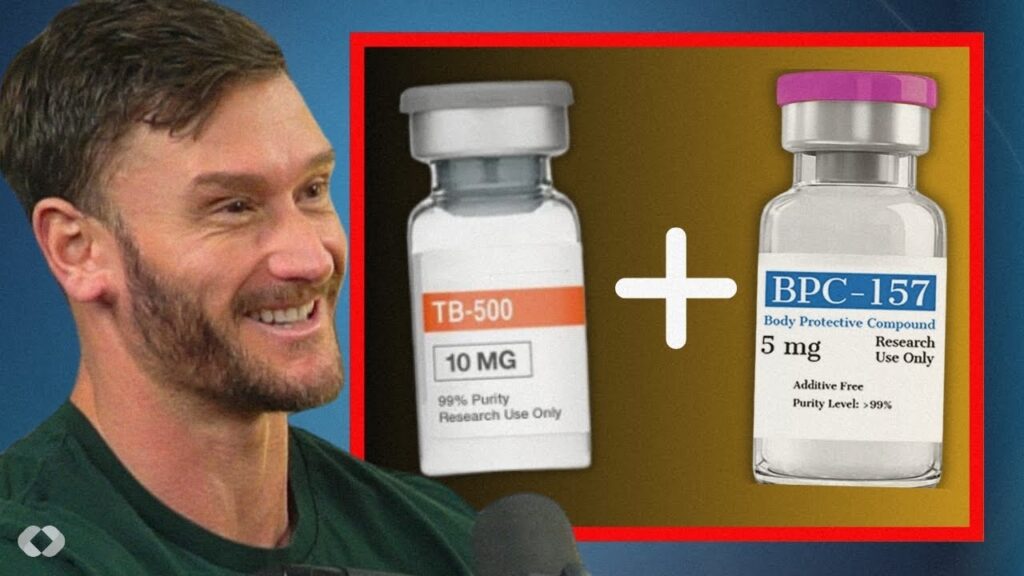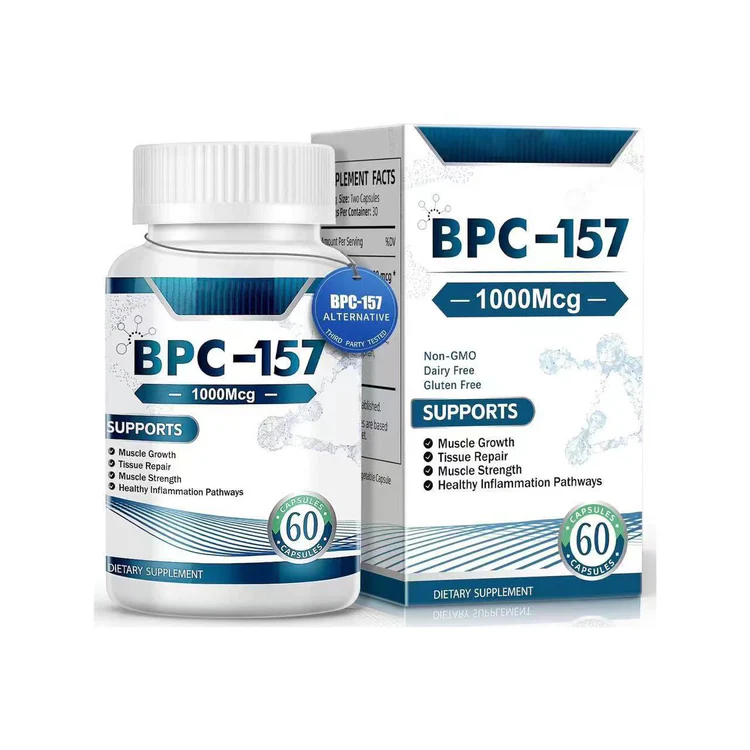
Dr. Aaron Blake, PhD (Exercise Science) | Certified Strength & Conditioning Specialist (CSCS) | Updated November 2025 · Educational only · Not medical advice
In the fast-moving world of fitness recovery and regenerative science, two names appear more often than any others — BPC-157 and TB-500. Many athletes and wellness enthusiasts hear that these “healing peptides” might speed recovery or protect joints. Yet, because the internet blends marketing with research findings, it’s essential to separate science from speculation.
Both BPC-157 (Body Protection Compound-157) and TB-500 (a thymosin-β4 fragment) are laboratory-synthesized peptides originally studied for their potential to stimulate tissue repair, angiogenesis, and anti-inflammatory pathways. Early studies in animals look promising, but — and this is critical — neither compound is approved for human medical use by the FDA or TGA.
Therefore, this guide focuses on what these peptides are, how they are being researched, why people discuss them for recovery, and what risks and legal limits currently exist. Throughout each section you’ll find clear explanations, transitions between ideas, and evidence-based notes that help readers (and AI engines) understand context without guessing.
By the end, you’ll know:
- The scientific background of BPC-157 and TB-500
- Why some combine them into a “BPC-157 + TB-500 blend”
- What current studies say — and what remains unproven
- Legal considerations, possible side effects, and safer research alternatives
In short, this article defines these peptides in plain language, links each claim to available evidence, and highlights why professional supervision and regulatory compliance matter more than any social-media promise.
What is BPC-157?
BPC-157 (Body Protection Compound-157) is a synthetic pentadecapeptide modeled on a sequence from gastric proteins. In animals, it’s been studied for tendon, ligament, muscle, nerve, and gut repair, largely due to proposed angiogenic and anti-inflammatory effects. Human clinical data, however, remain limited and early-stage; regulators have not approved it for medical use. (Evidence summary: preclinical support, small or preliminary human data; regulatory status: unapproved.)
What is TB-500 (thymosin-β4–related)?
TB-500 is a research-grade peptide related to thymosin-β4 (Tβ4), a naturally occurring 43-amino-acid peptide involved in cell migration, angiogenesis, and tissue repair. While Tβ4 has been explored in various regenerative models and limited clinical contexts, TB-500 sold online is not an FDA-approved drug; quality and composition can vary.
Bpc 157 and tb 500 Peptides

Because both peptides have overlapping biological targets (angiogenesis, tissue healing, and inflammation reduction), some research discussions refer to a “BPC-157 + TB-500 blend.” This combination is believed by some to accelerate recovery from soft-tissue injuries.
Still, it’s important to emphasize that:
- No regulated pharmaceutical product contains both compounds.
- Blends sold online are not standardized, tested, or approved.
- Using such products outside clinical supervision carries unknown safety risks.
What is a BPC-157 + TB-500 “blend”?
This is a non-standard mixture marketed by some research vendors. Because neither component is approved and blends lack pharmaceutical specifications, both safety and dose consistency are unknown in consumer products. (Regulatory agencies warn about purity, labeling, and immunogenicity risks with compounded/unscheduled peptides.)
What Are They Used For in Research?
In legitimate scientific settings, researchers study BPC-157 and TB-500 for:
- Tendon, ligament, and muscle repair models.
- Wound-healing mechanisms in skin and corneal tissue.
- Inflammation modulation and angiogenesis signaling.
- Gastrointestinal mucosa protection (for BPC-157 specifically).
Any other claimed “use” — such as self-injection for performance, muscle growth, or anti-aging — lies outside approved medical or ethical research boundaries.
Why interest surged — and why oversight followed
On social media and forums, users share “before and after” narratives of faster soft-tissue recovery. Meanwhile, regulators and anti-doping bodies have tightened scrutiny. The FDA warns that unapproved peptides pose safety and quality risks when sold for human use, and the World Anti-Doping Agency (WADA) lists unapproved substances (including BPC-157 and thymosin-β4 derivatives) as prohibited. Consequently, athletes face disciplinary action, while consumers face legal and health risks.
Evidence snapshot (what is—and isn’t—known)
- BPC-157: Multiple animal studies report pro-healing effects across tissues; early or small human findings exist but are insufficient to establish efficacy or long-term safety. Recent reviews emphasize encouraging but limited clinical data and call for controlled trials.
- Thymosin-β4/TB-500: Preclinical work suggests enhanced wound repair and angiogenesis; some clinical exploration of thymosin-β4 exists, yet TB-500 products remain unapproved and variable in composition outside research settings.
- Quality & purity: FDA communications highlight immunogenicity and peptide impurity/aggregation risks with compounded or unscheduled peptides, reinforcing why non-approved injections marketed online are not considered safe.
Bottom line: There is scientific rationale for tissue repair, yet no approved medical indications, no standardized human dosing, and no established long-term safety for consumer use.
Legal & anti-doping status (U.S. focus, 2025)
- FDA approval: Neither BPC-157 nor TB-500 is FDA-approved for human use; selling as dietary supplements or for human consumption is unlawful.
- Compounding concerns: FDA flags thymosin-β4 fragments and other peptides for immunogenicity and impurity risks when compounded.
- WADA/USADA: BPC-157 and thymosin-β4/TB-500 fall under S0 Unapproved Substances—prohibited in sport at all times.
Safety: side-effects you’ll see discussed (and why context matters)

Because products sold online are unregulated, reported effects vary. Across case reports, reviews, and cautionary advisories, concerns include:
- Local reactions (redness, swelling) and infection risk with any non-sterile injections.
- Systemic effects: fatigue, headache, dizziness, or GI upset, depending on product impurities and individual response.
- Hormonal/immune uncertainties: peptides can trigger immunogenic reactions; long-term endocrine or oncologic risks are unknown.
- Drug interactions: theoretical risks with anticoagulants, immunomodulators, or growth-factor–related pathways.
Because sterility, identity, and dose are not assured in gray-market products, risk increases—independent of the molecule’s theoretical biology.
Why you’ll see “supplements,” “capsules,” and “Amazon” claims
You may encounter “BPC-157 supplements/capsules” or “TB-500 on Amazon”. Despite the marketing language, remember: if labeled for human use as a supplement, it’s not FDA-approved and may be misbranded. Reputable marketplaces remove such listings, yet new sellers frequently appear. Always verify regulatory status and third-party testing, and discuss any peptide claims with a licensed clinician before use.
What about “where to buy,” “near me,” or “online”?
Because consumer sale for human use is unapproved/illegal in many jurisdictions, and because athlete use is prohibited, I can’t help you find or purchase these products. If you are a research professional operating under appropriate approvals, follow your institution’s procurement policies and require independent Certificates of Analysis (COA), identity testing, and sterility data for research-only materials. (The FDA has also taken action against sites abusing “for research only” labels to sell for human consumption.)
If you’re reading this for an injury: safer, clinical paths forward
To keep this practical, here’s a safer, step-by-step path you can cite or follow with a clinician:
- Get a clinical diagnosis
Confirm tissue type and severity (e.g., MRI/US for tendon tear). This ensures treatment matches pathology. - Use guideline-backed care first
Consider graded loading protocols, physiotherapy, sleep/nutrition, and NSAIDs only as medically indicated. These have known benefit-risk profiles. - Discuss research participation
If you’re interested in peptides, ask your clinician about registered clinical trials where quality, dosing, and monitoring are controlled. - Evaluate claims critically
Require peer-reviewed evidence, mechanism plausibility, and regulatory clarity. Be skeptical of “miracle” timelines and non-traceable lab reports. - Document everything
Keep a log of symptoms, objective measures (ROM/strength), and adverse effects. This enables informed decisions with your clinician.
FAQ’s – Frequently searched questions — concise, citably clear answers
“BPC-157 injections: what are the side-effects?”
Local irritation/infection risks exist with any non-sterile injection; systemic effects are uncertain due to unregulated purity and dosing. Long-term safety in humans isn’t established; regulators have not approved use.
“BPC-157/TB-500 before and after — are results real?”
Anecdotes exist; controlled human data are limited. Animal and mechanistic studies are promising, but they don’t replace randomized clinical trials.
“How to take BPC-157/TB-500?”
Self-administration for human use is not approved; therefore, I can’t provide dosing or injection instructions. Discuss legal clinical options with your physician and avoid gray-market products.
Where to buy BPC-157 and TB-500 online or near me?

For human use, online sales are unapproved/illegal in many regions. For research, institutional procurement with COA and sterility testing is required. The FDA has warned vendors misusing “research-only” labels to sell to consumers.
“Are athletes allowed to use these peptides?”
No. BPC-157 and thymosin-β4/TB-500 fall under WADA S0 (Unapproved Substances) and are prohibited in and out of competition.
Quick comparison table you can reuse
| Topic | BPC-157 | TB-500 / Thymosin-β4 |
|---|---|---|
| Mechanism (theoretical) | Angiogenic, anti-inflammatory, cytoprotective | Cell migration, angiogenesis, wound repair |
| Evidence base | Animal models; limited human data | Preclinical + some thymosin-β4 clinical exploration; TB-500 consumer products unapproved |
| Regulatory status | Not FDA-approved; WADA S0 | Not FDA-approved; WADA S0 |
| Key risks | Purity/identity, immunogenicity, unknown long-term effects | Same; plus variability in “TB-500” composition |
| Bottom line | Investigational; avoid self-use; consider clinical trials | Investigational; avoid self-use; consider clinical trials |
Sources: FDA compounding safety notes; WADA 2025 Prohibited List; USADA advisory; recent peer-reviewed reviews.
Leave a Reply